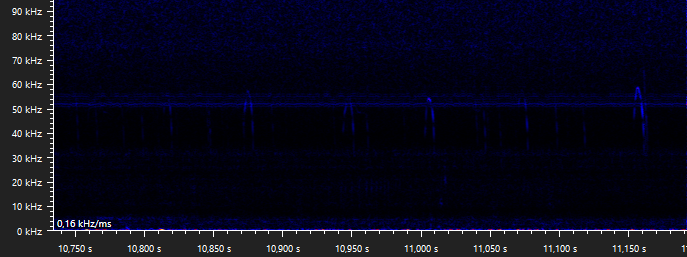Echolocation of bats in the Netherlands
Bats use echolocation to navigate and hunt, but they also make calls for communication. When a bat is hunting, the proces of catching an insect becomes visible by a so called feeding buzz. Examples of feeding buzzes can be found on the Feeding buzzes page. Calls used for communication can be found on the Social calls page.
The echolocation of bats are a great way to identify bat species, because the calls of each species has it's own specifications. The shape of the call, the peak frequency of the call, the start and end frequency of the call, the call length and the inter-pulse interval can all be important indicators to determine the species you are dealing with. Two great guides for bat identification are "Bat Calls of Britain and Europe" edited by Jon Russ and "Acoustic Ecology of Europan Bats" by Michel Barataud.
Unfortunately, the Echo Meter Touch 2, the device used to make most recordings in this database, occasionally seems to have a little "blind spot" between 50 kHz and 60 kHz, creating a little gap in the sonograms and thus slicing calls around that frequency.
Different shapes
FM-qCF shaped calls are similar to a hockeystick or a bend: ╰
qCF shaped calls are similar to a mostly horizontal stripe: —
FM shaped calls are similar to a mostly vertical stripe: I
qCF-FM shaped calls are similar to the right half of a rainbow: ╮
Peak frequency: the frequency (kHz) at which the call is loudest.
Start (maximum) frequency: the frequency (kHz) at the start of the call.
End (minimum) frequency: the frequency (kHz) at the end of the call.
Call length: the duration of the call (ms) from start to end.
Inter-pulse interval: the amount of time (ms) between calls.
Examples
Common noctule (Nyctalus noctula)
Peak frequency often around 20 kHz - most often qCF calls, sometimes alternated with FM-qCF calls - a relatively long inter-pulse interval - chip-chop sound

Date of recording: 2024-06-07 Recorded by: Timo Boer Audio file: 912080
Serotine bat (Eptesicus serotinus)
Peak frequency often around 25 kHz - most often FM-qCF calls, but qCF possible - tapdancer sound

Date of recording: 2024-06-03 Recorded by: Nanieke van den Berg Audio file: 912083
Nathusius pipistrelle (Pipistrellus nathusii)
Peak frequency often around 40 kHz or below - FM-qCF or qCF calls

Date of recording: 2024-05-30 Recorded by: Rianne Bunschoten Audio file: 912086
Common pipistrelle (Pipistrellus pipistrellus)
Peak frequency often around 45 kHz - most often FM-qCF calls, but qCF possible

Date of recording: 2024-05-23 Recorded by: Romee Bleijenberg Audio file: 912090
Soprano pipistrelle (Pipistrellus pygmaeus)
Peak frequency often around 55 kHz - most often FM-qCF calls, but qCF possible

Pond bat (Myotis dasycneme)
Peak frequency often around 35 to 40 kHz - high start and low end frequency - can produce calls with relatively long call length - rattle sound

Date of recording: 2024-05-18 Recorded by: Abe-Jan van der Wal Audio file: 912118
Daubenton's bat (Myotis daubentonii)
Peak frequency often around 45 to 50 kHz - high start and low end frequency - short call length - rattle sound

Date of recording: 2024-07-08 Recorded by: Zsuzsanna Szabo Audio file: 919356
Brown long-eared bat (Plecotus auritus)
Peak frequency often between 20 - 30 kHz - FM calls - calls contain harmonics - quiet crackling sound

Date of recording: 2024-06-26 Recorded by: Boaz van Die Audio file: 916851
Deviations
Bats leaving their roost
Directly at emergence from the roost, echolocation calls are typically short in duration and elevated in frequency and are not typical of free-flying bats (Newson, 2024).
Common noctule leaving it's roost:

Date of recording: 2024-04-28 Recorded by: Dennis Rademaker Audio file: 920109
Serotine bat leaving it's roost:

Date of recording: 2024-05-19 Recorded by: Sander Boersma Audio file: 912051
Brown long-eared bat leaving it's roost:

Date of recording: 2024-07-13 Recorded by: Boaz van Die Audio file: 921381
Common pipistrelle leaving it's roost:

Date of recording: 2024-06-17 Recorded by: Sarah Mahie, Boaz van Die Audio file: 914381
Modified echolocation calls
Examples of modified echolocation calls are very rare and so far previous literature written about these calls have not been able to determine the context behind such emissions. They may be communicative, at least to some degree (Middleton et al., 2020).
Hooked echolocation calls of the common pipistrelle:


Hooked echolocation calls of the Nathusius' pipistrelle:

More: 912056
Hooked echolocation calls of the common noctule:


Not to be confused with the social calls shaped like walking sticks of the pond bat and the Daubenton's bat. And, perhaps, there is also some similarity to the rare social calls of the serotine bat emitted while in flight that can appear as arches.
Social calls of the Daubenton's bat:


More: 931817
Social calls of the pond bat:

Date of recording: 2024-06-06 Recorded by: Anice Hut Audio file: 911253
Social calls of the serotine bat:

Date of recording: 2024-07-24 Recorded by: Charlotte Serrarens Audio file: 923069
All recordings are licensed under the following Creative Commons Attribution-NonCommercial-NoDerivs 4.0 license and in courtesy of Sarah Mahie.
All sonograms are screenshots of the recordings imported in the ultrasound analysis software BatExplorer 2.2 (Elekon, Switzerland).
Bibliography:
- Jon Russ (2021). Bat Calls of Britain and Europe: a Guide to Species Identification. Pelagic Publishing.
- Michel Barataud (2020). Acoustic Ecology of European Bats. Species Identification, Study of their Habitats and Foraging Behaviour (Anya Cockle-Betian, trans.). Second edition. Inventaires & biodiversité series. Biotope - Muséum national d'Hostoire naturelle.
- Neil Middleton, Andrew Froud and Keith French (2022). Social Calls of the Bats of Britain and Ireland (second edition). Pelagic Publishing.
- Stuart Newson (2024). https://www.linkedin.com/posts/stuart-newson


Create Your Own Website With JouwWeb